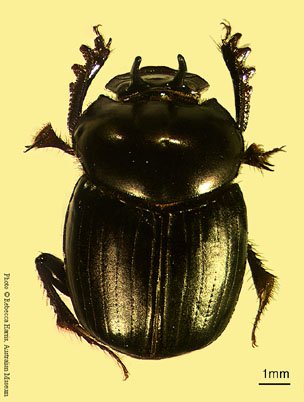![]()
![]()
![]()
Genus Onthophagus
 Species found in eastern New South Wales: O. anchommatus, O. arrilla, O. atrox, O. auritus, O. australis, O. bicarinaticeps, O. bornemisszai, O. capella, , O. chepara, O. compositus, O. declivis, O. depressus, O. desectus, O. dunningi, O. fletcheri, O. frenchi, O. fuliginosus, O. glabratus, O. granulatus, O. hoplocerus, O. incornutus, O. kiambram, O. koebelei, O. kokereka, O. kumbaingeri, O. leanus, O. leai, O. longipes, O. macleayi, O. macrocephalus, O. mutatus, O. muticus, O. nammuldi, O. neostenocerus, O. nurubuan, O. ouratita, O. pentacanthus, O. peramelinus, O. pexatus, O. pronus, O. pugnax, O. quadripustulatus, O. quinquetuberculatus, O. rubicundulus, O. squalidus, O. sydneyensis, O. tabellifer, O. tenebrosus, O. tweedensis, O. tuckonie, O. waterhousei, O. weringerong, O. williamsi, O. yourula.
Species found in eastern New South Wales: O. anchommatus, O. arrilla, O. atrox, O. auritus, O. australis, O. bicarinaticeps, O. bornemisszai, O. capella, , O. chepara, O. compositus, O. declivis, O. depressus, O. desectus, O. dunningi, O. fletcheri, O. frenchi, O. fuliginosus, O. glabratus, O. granulatus, O. hoplocerus, O. incornutus, O. kiambram, O. koebelei, O. kokereka, O. kumbaingeri, O. leanus, O. leai, O. longipes, O. macleayi, O. macrocephalus, O. mutatus, O. muticus, O. nammuldi, O. neostenocerus, O. nurubuan, O. ouratita, O. pentacanthus, O. peramelinus, O. pexatus, O. pronus, O. pugnax, O. quadripustulatus, O. quinquetuberculatus, O. rubicundulus, O. squalidus, O. sydneyensis, O. tabellifer, O. tenebrosus, O. tweedensis, O. tuckonie, O. waterhousei, O. weringerong, O. williamsi, O. yourula.
4 introduced species have become established in eastern NSW, O. binodis, O. gazella, O. nigriventris & O. taurus.
Other species: There are at least 215 described species of Onthophagus throughout Australia.
Distribution
Onthophagus occurs across Australia, in all major habitat types. The genus is cosmopolitan, with more than 2000 species.
Description
Small to large (2-11mm long), generally black and shiny, some species metallic, pale coloured or matt, some with smooth elytra, others rugose or tuberculate. Dorsal surfaces glabrous or hairy. The clypeal margin is not toothed.
Elytra: elytra with 8 striae. No pseudepipleura.
Hind wings: Fully developed or, rarely, reduced (one undescribed species).
Legs: Outer edge of fore tibiae with 4 teeth (3 if worn). Middle coxae parallel. Middle and hind tibiae strongly dilated apically, without a transverse keel on outer face. Claws either simple, subdentate, or prehensile.
Abdomen: Sternites normal. Pygidium generally exposed, without grooves or depressions.
Sexual dimorphism
Male with medially shortened last abdominal sternite. Other differences are species dependant, and include an elongated fore tibia in males, with smaller teeth, a more angular inner apex or a brush of setae, and different head and pronotal armament.
Similar Genera
Thyregis, of a similar size and general shape (some species), black and shiny, middle coxae parallel.
Obvious differences: Thyregis with 2 clypeal teeth, outer edge of fore tibiae with 3 teeth, and elytra with 10 striae.
Diorygopyx, of a similar size and general shape as some species, black and shiny.
Obvious differences: Diorygopyx with 2 clypeal teeth, convergent middle coxae, base of pygidium grooved, no head armament in any species, 3 teeth on outer edge of tibiae.
Ecology
Includes nocturnal and diurnal species, coprophagous, necrophagous, and fungivorous species, flightless (1) and winged species. In closed forest, tall open forest, open forest, woodland, open scrub, open pastures and sand dunes.
A few species (eg. O. muticus, O. parvus) have prehensile claws, which enable the beetle to cling to the hairs around the anus of mammals and fall to the ground with the dung as it emerges.
Notes
At least 4 undescribed species occur in eastern NSW.
References
Cassis, G. & Weir, T.A. (1992) Scarabaeinae. pp 106-173. In: Houston, W.W.K. (ed.) Zoological Catalogue of Australia. Coleoptera: Scarabaeoidea. Canberra: AGPS Vol. 9.
Matthews, E. G. (1972) A revision of the Scarabaeine Dung Beetles of Australia. I Tribe Onthophagini. Aus. J. Zool. Suppl. Ser. 9: 1-330
Storey, R. I. (1977) Six new species of Onthophagus Latreille (Coleoptera: Scarabaeidae) from Australia. J. Aust. ent. Soc. 16: 313-320.
Storey, R. I. & Weir, T. A. (1990) New species of Onthophagus Latreille (Coleoptera: Scarabaeidae) from Australia. Invertebr. Taxon. 3:783-815
Tyndale-Biscoe, M. (1990) Common Dung Beetles in Pastures of South-eastern Australia. CSIRO Division of Entomology.
